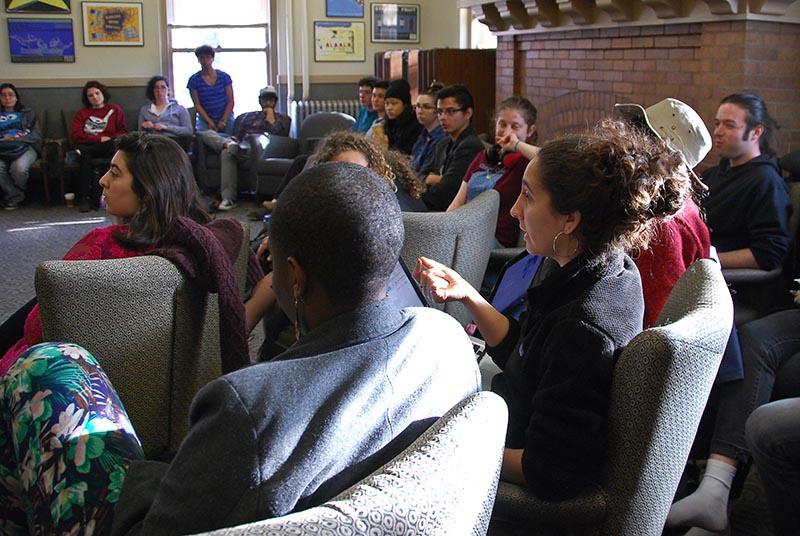Senate Forum Focuses on New Student Support Fund
College junior Dyaami D’Orazio discusses her thoughts on the allocation of the new Student Support Initiative Fund. The fund has over $700,000 for students of color and disabled, low-income or at-risk students.
May 1, 2015
Students discussed the allocation of the Student Support Initiatives Fund during a Student Senate-led forum on Tuesday evening. Board of Trustees Chair Clyde McGregor donated $500,000 to create the fund for students of color, low-income, at-risk or disabled students. Other donors have since pledged more money to the fund, increasing the total to about $700,575.
The fund was created after College senior and Student Senator Megs Bautista had breakfast with President Krislov to convey her concerns regarding the lack of support for low-income students beyond the financial aid packages granted during the admission process.
“I was like, ‘So it’s really awesome that you guys give us generous financial aid packages when you do, but you kind of stop and forget about us after the fact,’” Bautista said during the forum on Tuesday. “So once the paperwork is in, what happens to my books? … What happens when my computer happens to break, which it did? So on and so forth. … There’s a post-FAFSA or financial aid or whatever burden that is not being paid attention to.”
During the forum, students discussed how to best allocate the fund, as well as the definition of the vague stipulation “at-risk.”
Senator and double-degree sophomore Jeremy Poe said that by defining “at-risk,” students can interpret this term for the administration and influence the fund’s allocation.
“When Clyde gave this money, the only stipulations he gave were these words,” Poe said during the forum. “I was talking to [Vice President and Dean of Students] Eric Estes, and he’s going to push for, by next week with Krislov, having [a] more clear-cut procedure for how we encourage them to use this fund, or who it should be used for and what the stipulations should be. I think that’s why this conversation is valuable, because we can push for that and push for a better understanding instead of just the phrase “at-risk” and “low-income.” Our definition of what that means I think is very important, and having a better understanding will let us advocate better.”
Some students suggested that the category of “at-risk” overlaps with the other groups outlined in the fund’s language as possible recipients: low-income, first-generation and disabled students, as well as students of color. However, others discussed a more expansive definition of “at-risk,” which included students who struggle or have struggled with drug or alcohol addiction.
Bautista also raised the possibility of using the fund to support students during specific events that may put them at-risk.
“The Oberlin College Republicans and Libertarians just brought this speaker to campus [who] was terrible,” she said. “There were events that happened as alternative spaces that were requesting funding so that they could program. Does that count as “at-risk”? … I personally think it does.”
After proposing several definitions for “at-risk,” students discussed possible programs to support, expand or create using money from the fund. These proposals included plans to increase the financial accessibility of club and intramural sports, traveling home and summer work-study programs or internships.
Some expressed hope that the fund could fill in the gaps left by other programs, such as the recently expanded Emergency Book Fund, which provides loans, not direct funds, for any student who needs assistance buying books for class. Several students want this new fund to provide money for supplies for art classes and textbooks without requiring the users to pay the school back.
College senior and Student Senator Molly Brand emphasized that this will be an ongoing fund and an opportunity to support smaller initiatives.
“This fund is not established to be spent all at once, so we don’t have to be thinking of [the] biggest possible way we can spend $500,000. But what are some small programs that [are] really important [to support] that you’ve heard of?” Brand asked.
A Senate working group will gather the ideas from this forum to organize a list of possible uses for the fund at a meeting on Sunday and then present the list of suggestions to Estes on May 7.
Estes said part of the fund has already been allocated to several programs and the Student Senate forum is a way to get additional student input.
“It is being used to support a range of services to support students, primarily related to economic accessibility but other critical support resources like disability support and mental and emotional health support,” said Estes in an email to the Review. “So some of the money has been committed to expand peer-mentoring programs like Peer Mentors and Student Accessibility Advocates and increase the yield of endowed funds for books and medical emergencies. The fund is helping to support part of [the new] position in [Office of Disability Services] and the piloting of Saturday hours at Student Health Services. These priorities were created with input from students. Senate is soliciting input from students on potential additional allocations of the funds.”


























